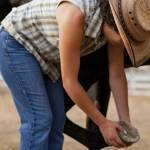Lameness or Ataxia: What’s Wrong With Your Horse?

Most horse owners can tell when their horses are not moving the way they should. The horse might favor one foot, or be reluctant to pick up the proper canter lead, or just seem a little unsure of where its legs are. Most causes of uneven movement can fall into one of two broad classifications: lameness and ataxia.
When a horse has an uneven gait because of pain or stiffness, it’s said to be lame. Its discomfort might be caused by a muscle or tendon injury, a hoof abscess, bruising from a accident, or an injury to a bone or joint in the leg, among other possibilities. A lame horse will probably show the same head-bob or short stride in a rhythmic pattern as it trots slowly, but some lamenesses are apparent at the walk. It may be hard for an owner to figure out what’s causing the lameness and exactly which leg is affected, but it’s fairly easy to detect the same faulty motion on each stride.
Horses that are moving incorrectly because of neurologic problems may not show this repetitious gait abnormality. Instead, the horse with ataxic (irregular or inconsistent) movements may sway, wobble, or stumble. The problem may be subtle or quite evident, but the key difference from lameness is the variation from stride to stride. A horse that has problems with its brain or spinal cord often has poor proprioception (an awareness of where its legs and feet are in relation to its body). These horses may take steps of different lengths, tread on their own feet when turning, or be unable to stay balanced as they move.
By watching a horse in motion, a veterinarian can usually tell whether the horse is lame or ataxic and also where the problem is. Depending on his findings, the veterinarian can do more testing to pinpoint the cause of the uneven gait, begin treatment, and advise the owner about the horse’s prognosis.








